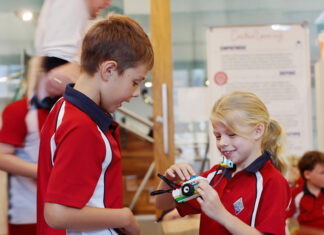When European settlers arrived in Australia they would have seen a landscape like that of a country estate, with well defined areas of grasslands, trees, forests and deserts, organised by the traditional custodians and managed though the use of fire, Di Collier told guests at Noosa Parks Association Friday Forum this month.
Di Collier has a private nature refuge, Dungi Yandi, in the headwaters of the Mary River, near Conondale in the Sunshine Coast hinterland which she has owned for almost 50 years.
She spoke about fire from the perspective of using it as a land management tool. Hers is a personal story of deep observation and caring for country where the land itself has shifted her thinking and attitudes.
Di’s first successful ecological burn was a cool burn conducted downhill with an outcome that “couldn’t have been better“ leaving the understorey scorched. The second burn, a few weeks later, took more understorey.
Four years on, the understorey has returned with an increase in native grasses, seeds that have laid dormant in the ground for more than 14 years have come alive and there are more herbaceous scrubs, she said. Other species affected by dieback have sprung back to life.
Initially fearful of fire in the landscape, Di now loves fire.
“Fire has been the icing on the cake of managing my property and rehabilitating it,“ she said.
About 18 months ago Di joined four neighbouring landowners, all Land for Wildlife members whose properties together comprise about 600 acres, to organise ecological burns.
The process was well planned, involving workshops, the creation of fire management plans, fire hazard maps, weather forecasts, identification of fire trails, fire breaks and emergency exits and consultation with fire services.
Di said burns have to be the right burn for the intended purpose and dependent on a number of factors including use of the land, soil type, rainfall, seasonal indicators and the time since the last fire.
Her use of fire has changed the way Di views the landscape and made her feel more connected and responsive to it.
Looking at the land historically, she said First Nations people managed the country as you would an estate, but using fire.
It had healthy grasslands to lure kangaroos, making them easy prey. Hills and slopes with lines of trees. It was nothing like the national parks today.
Di said the mosaic landscape as well as frequent burning of areas by Aboriginals was noted in Captain Cook’s journal and evident in early landscape paintings.
Di now sees bushland with dense undergrowth as a landscape that has been badly managed due to ignorance and neglect.
Forest thickening is an indication of a sick country, she said.
“There are many more trees now than at settlement,“ she said.
“There’s far more fuel for wild fire than reasonable, fire that gallops up to the canopy.“
Di said her knowledge had resulted from being in one place for one time but there was a vast body of knowledge available from traditional owners, academics and organisations which was vital to share in future management.
. “We need to observe and listen before we take action,“ she said.
“We need to change the way we think and see, change our colonial aesthetic,“ she said.
“There was no wilderness until the Europeans came. Aboriginals shaped Australia. Can we say we are managing our country?“







